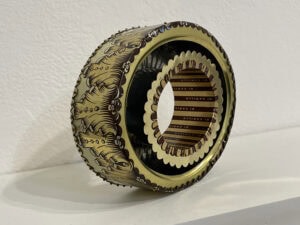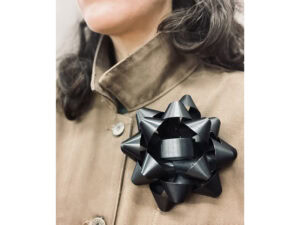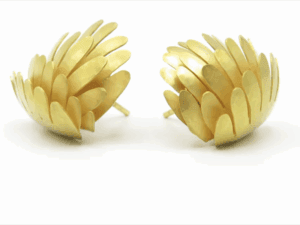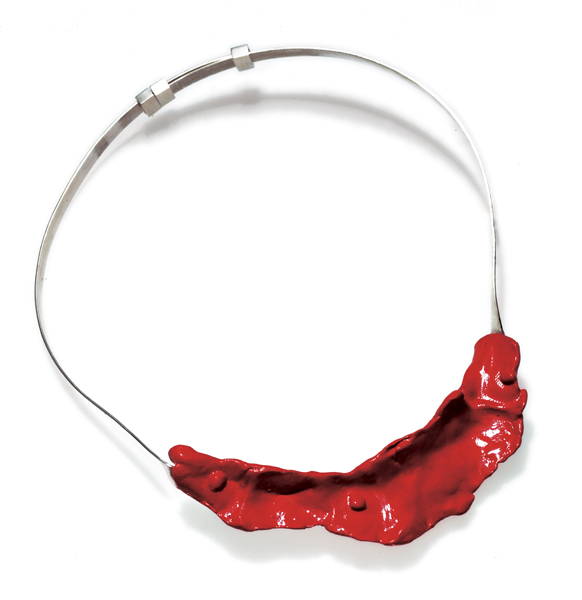
Art and Jewelry, A Journey from Beijing to Berlin
Teng Fei received a BA degree from CAFA in 1987, majoring in woodcuts, and afterward worked at the Beijing Institute of Fashion Technology. In 1990, she went to Germany and completed an MFA program at the art academy in Berlin in 1995, where she created installations, objects, and jewelry.
To Teng Fei, the Academy of Arts in Berlin was a place without boundaries. The teachers did not lecture much and expected their students to go out and engage in their own practices outside of school. Teng Fei was attracted to jewelry because of the handmade element of the process and the qualities of the materials. Also, she felt that contemporary jewelry was not part of the mainstream of art or design but something special. Planting this new idea in her home country seemed fascinating. And this is what Teng Fei set out to do when she returned to China.
However, things did not immediately work in her favor. For the first seven years after coming back, Teng Fei was employed in the department of design at CAFA. She says, “If one wanted to do design, it was about being a big-picture thinker; the scope couldn’t be too narrow. I brought up the idea of jewelry, but got no feedback. In many respects, China in the 90s lacked the premises for this kind of major. Back then, there was no money for this. I guess that first people need to eat well, have an apartment and a car. Only after this, they are free to think about other things.”
It was only in 2002 that the experimental materials class became a subject of study at CAFA. Teng Fei started teaching this class; later on she built a jewelry studio, and finally she founded the jewelry department.
Art, Jewelry and Experiment
What is an experimental materials class about? And why start with this type of class instead of founding a jewelry program right away? I suspect that the title of the class is partly due to a governmental program because, around the same time, other universities like Shanghai founded studios called “multi material” and the like (see the author’s interview with Shannon Guo). There are other reasons, however.

And what about experimental jewelry? “For something to be experimental it must have intellectual inquiry behind it,” Teng Fei explains. “The maker must be concerned with a question, must point to something specific. After that, he or she must find the means to build a methodology toward providing a viable solution. In a discussion about jewelry there is first the traditional definition of the craft, then the issue of jewelry and its relationship to people, and then the question of the idea of jewelry as ‘being worn.’ Through it all there are possibilities for linear, multidimensional, and subversive interrogations—of history, of the present, of culture, of society, of humankind, of philosophy, and so on.”[1]
While I agree with Teng Fei’s reasoning, I ask myself at the same time if what she is describing is not self-evident practice in art academies.
The Old and the New
When Teng Fei came back from Germany, she felt that the curricula at the Chinese art academies were too strict. The students were pushed into a certain direction and forced to work toward a preexisting goal. She observed that creativity was extinguished instead of nurtured, and some students had become passive and uninterested.
The reality is that in many universities in China, studying art is still about technical skill-building employing rote methods and the discipline of practicing for endless hours, following step-by-step instructions or copying masterworks until reaching perfection.
This practice seems to have been carried over from the master-disciple tradition in the Chinese arts, which is still in place. In fact, following a master’s instructions, learning by copying masterpieces, and thus achieving technical perfection was for a long time also the teaching method at Western universities. However, at some point, the focus changed to nurturing a student’s ability to express him- or herself.[2]
The large size of a class might also explain why the rote learning method still prevails. How else could one teacher deal with sometimes more than 50 students at the same time? While there might be other solutions to this challenge, the obvious one is to state a desired goal, establish a predefined aesthetic, and have the student acquire the necessary skills through instructions or copying. Once the task is accomplished, the teacher might review the results in private and dole out scores without any comments. Anyone wanting feedback needs to ask for it.
![Tian Yuan Zhi Xiao [田园知晓], Mildew, 2011, necklace, donkey skin, watercolor, 300 x 250 x 80 mm, photo: artist Tian Yuan Zhi Xiao](https://artjewelryforum.org/sites/default/files/images2014/interviews/china-contemporary-jewelry-on-the-rise-part-2/content/3tianyuanzhixiao600px.jpg)
While this might be a very effective and efficient way to get students into the art academies, it effectively stifles their creativity and curiosity while shaping their expectation about what studying art and art itself are about in a profound way.
Teng Fei’s approach of experimenting must come as a shock to these students (though hopefully as a shock that rocks them back into a creative and artistic mind-set and helps them find their own way). Her teaching focuses on finding a way to activate her students’ curiosity and thus to inspire them to take the initiative in exploring new ideas, materials, and ways to express themselves. In class, she reminds them that what they are doing is not “homework” but artwork. Teng Fei thinks that while it is important to learn techniques, it is as vital to experiment on one’s own accord. In order to become a good artist or designer, heart, sense, sensibility, and technical skills have to come together, “going hand in hand.” Teng Fei is convinced that if they strive into different directions, the result will not be satisfactory. She adds, “If students can consciously invest enough energy into the problem-solving process, they will ultimately produce good work. On this subject, the potential impact one can have on students is very great. Whether what they do afterward is design or art, their demands of superiority in material aesthetics will be an indispensable component of their success.”
![Qu Wan Ni [曲婉妮], Sand Time, 2013, ring, brass, glass, 50 x 40 x 30 mm, photo: artist Qu Wan Ni](https://artjewelryforum.org/sites/default/files/images2014/interviews/china-contemporary-jewelry-on-the-rise-part-2/content/4quwanni600px.jpg)
Teng Fei says, “In the beginning I used the term ‘experimental jewelry’ in order to illustrate that what we are doing is indeed ‘experimental’ in the sense of not being perfect and finished. Thus, we were free to combine different ways of thinking and materials, to let our creativity run wild. The term ‘experimental’ warns people to not expect a polished result. If you experiment, people’s feedback might not be supportive. Hence, experimenting also means to be brave enough to strike a new path. While this is not always easy, it is important to go that way.”
While in the West coming up with something new is seen to some extent as something good in itself, in China it is only a good thing if it is also successful. In the latter case, many others will jump on the bandwagon to reap the success. If it is a failure, however, it seems to me that it is in general not seen as a learning experience and thus a steppingstone for future success like it might be in the West. In China, failing appears to mean losing face.
Given this background, cultivating new ground in terms of introducing new teaching methods or another type of jewelry that is not composed out of precious materials is more difficult in China than in the West. Success and failure are distensible notions that not least depend on the observer’s point of view. In the eyes of a conservative person, introducing something new might be something bad and thus a failure in its own right. In this situation, using the term “experimental” is of help, indicating that it is a process and that the results might not be “polished.”
![Li An Qi [李安琪], Coldness, 2012, brooch, gypsum, blue ink, silver, 50 x 60 x 70 mm, photo: artist Li An Qi](https://artjewelryforum.org/sites/default/files/images2014/interviews/china-contemporary-jewelry-on-the-rise-part-2/content/5lianqi600px.jpg)
In contrast, given her convictions, Teng Fei will even support a student who is not open to her suggestions and takes a path that, from her perspective, is not advisable. Teng Fei explains: “In this situation, suggesting that what they are doing is wrong will only cause extra pain. It is a process; eventually the student will figure it out on his or her own and change.”
Forcing a student to take a certain path might achieve the short-term goal of reaching good results in the eyes of the teacher or the faculty but as soon as the student has left university he or she will be lost without their own aesthetic language and without their own critical approach to the work.
A Unique Way
China has seen some internal criticism of the traditional teaching methods at art academies and the call for a change. Reducing class sizes might be a good start, but this will not address the wider problem of method. What it needs are people like Teng Fei pushing and facilitating the change and people in charge at the top approving and supporting it.
In the end, changing the way young people are educated might also have implications for society. People who are taught in the traditional way of following instructions versus those taught to ask questions and develop solutions will also behave differently in everyday life. Of course, a few art students won’t make a big difference in China’s mass population, but still.
Striving to change the education at universities, people like Teng Fei look at Western models. However, they do not “copy and paste” it, but find their unique way to adapt it to the Chinese mind-set and environment. While, for example, technical skill development in Chinese universities might be overvalued and thus be stifling creativity, one wonders if this approach is not underrated in Western universities. Moreover, putting more emphasis for example on traditional techniques and transferring them into a contemporary context could lead to pieces with a unique cultural identity.
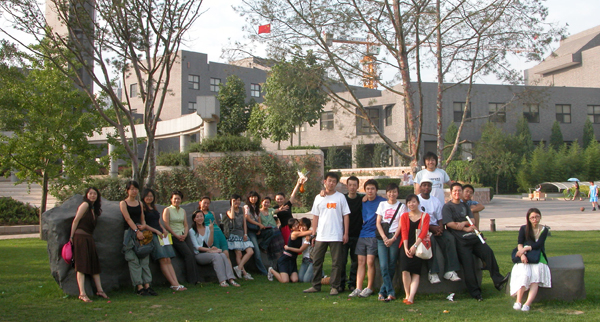
Preserving and shaping cultural identity is an important topic in China since the country is still in a process of reinventing itself. The idea of contemporary jewelry was brought from the West to China. However, here like in other cultural spheres, contemporary artists strive to strike a balance between being culturally receptive and expressing China’s cultural identity (see the article Griddle Incense Ass—or—Lost in Translation). The proof, however, is in the pudding: in the next article in this series we will have a look at how Teng Fei incorporates her own and Chinese identity into her pieces.
Index Image: Teng Fei wearing In That Summer, 2007, photo: Yao Lu
[1] Teng Fei, ed., Ten Years—Re: Jewelry, The Central Academy of Fine Arts and Contemporary Art Jewelry, 15.
[2] Kathryn Lowry and Constance Wolf, “Arts Education in the People’s Republic of China: Results of Interviews with Chinese Musicians and Visual Artists,” Journal of Aesthetic Education 22, no. 1 (Special Issue: Art, Mind, and Education, Spring, 1988): 89–98.
[3] Guo Juan, “Stuck in the Middle—Inside China’s Art Cram Schools,” Leap—The International Art Magazine of Contemporary China 8 (2011).

